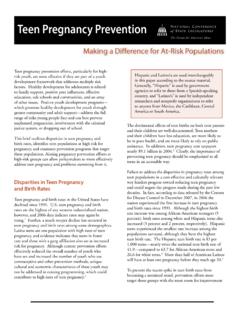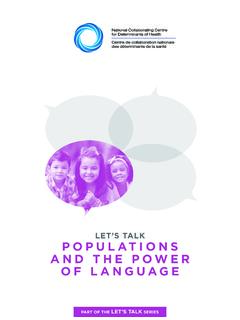Transcription of Giving Voice to Vulnerable Populations: Rogerian Theory
1 Jones & Bartlett Learning, LLC. NOT FOR SALE OR DISTRIBUTION. CHAPTER 9. Giving Voice to Vulnerable Populations: Rogerian Theory Sarah Hall Gueldner, Geraldine R. Britton, and Susan Terwilliger At the end of this chapter, the reader will be able to Objectives 1. Explain Rogers' perspective on vulnerability. 2. Describe the characteristics of vulnerability. 3. Defi ne well-being from the perspective of the research on Rogers' Theory described by the authors. The human condition of vulnerability is a concept of vital concern to nurses, in that a large portion of nursing practice is spent either helping individuals who fi nd themselves in a vulner- able position or helping them avoid vulnerability.
2 Nursing, however, has been slow in developing theoretical constructs of vulnerability within a nursing perspective (Spiers, 2000). Traditional defi nitions of vulnerability are framed within an epidemiological approach to identify individu- als and groups at risk for harm. Groups most often labeled as Vulnerable include the elderly, children, the poor, people with disability or chronic illness, people from minority cultures, and captive populations such as prisoners and refugees (Saunders & Valente, 1992). Labels of vulnerability are customarily applied in relation to socioeconomic, minority, or other stigma- tizing status (Demi & Warren, 1995) and reflect a tendency to blame the victim for his or her status rather than the prevailing social structures.
3 The generally accepted marker for vulner- ability has been the inability to function independently in accord with the values of a particular society. Fortunately, there is growing dialogue about vulnerability from the perspective of the person experiencing it a view that is more congruent with the philosophical stance of nursing (Morse, 1997; Spiers, 2000). 125. Jones & Bartlett Learning, LLC. NOT FOR SALE OR DISTRIBUTION. 126 Chapter 9 Giving Voice to Vulnerable Populations: Rogerian Theory The Rogerian conceptual system (Rogers, 1992), which focuses on the person as integral with and inseparable from his or her environment, holds considerable relevance as an inno- vative nursing framework to use in addressing the problem of vulnerability.
4 Accordingly, the remainder of this chapter is directed toward application of the theoretical base of Rogerian nursing science to the human condition of vulnerability. Because persons who are Vulnerable are at greater risk for not being heard, the last section of the chapter describes the Wellbeing Picture Scale (WPS), a 10-item innovative picture-based tool that offers a menu of paired pic- tures rather than words, Giving people who may not be able to read English text an alternative, more user-friendly way of expressing their sense of well-being.
5 A Rogerian PERSPECTIVE OF VULNERABILITY. According to Martha Rogers, energy fields are the fundamental unit of everything, both living and nonliving. These fields are without boundary and dynamic, changing continuously. Two energy fields are identified: the human field and the environmental field. Rogers emphasized that humans and environments do not have energy fields; rather, they are energy fields. Like- wise, she insisted that the human field is unitary and cannot be reduced to a biological field, a physical field, or a psychosocial field.
6 As postulated by Rogers, human and environmental fields flow together in a constant mutual process that is unitary rather than separate. Within this worldview, humans are energy fields that exist in constant mutual process with their immediate and extended environmental energy field, which includes, and cannot be separated from, other living and nonliving fields. She also postulated that both human and environmental energy patterns change continually during this process. The inseparability of the human energy field from its immediate and extended environmental energy field is perhaps the most central feature of the Rogerian conceptual system.
7 Phillips and Bramlett (1994) assert that the mutual human environmental field process can be harmonious or dissonant. Resonant with Rogers' science, these researchers posit vulnerability as an emergent condition that arises when there is dissonance within the mutual human environmental field process. This view is consistent with Rogerian scholar Barrett's (1990) Theory of power, which associates power with individuals' knowing partici- pation in change within their mutual human environmental process for the betterment of the whole, including themselves.
8 These authors perceive vulnerability as the opposite condition of power as a condition that may occur when an individual is unable or does not choose to par- ticipate in an informed and purposeful way in change. Persons in this situation essentially have no Voice and may be intentionally or unintentionally left behind in a compromised position. Within this line of thinking, an individual's sense of dissonance or disharmony within the mutual human environmental field process would be viewed as a manifestation of vulnerability, placing individuals or groups at risk.
9 Barrett developed a text-based tool, Power as Knowing Participation in Change (PKPC), to measure this concept; a subscale of the tool addresses awareness as an essential feature of knowing participation. Lack of knowing participation may be associated with a number of scenarios. Indi- viduals may be uninformed or misinformed about situations involving their unique Jones & Bartlett Learning, LLC. NOT FOR SALE OR DISTRIBUTION. A Rogerian Perspective of Vulnerability 127. human environmental field process, or they may be unable to participate due to one or more specific circumstances such as illness ( , stroke or dementia) or injury ( , hip fracture).
10 Common situations that may limit or prevent knowing participation include compromised vision or hearing, aphasia, difficulty with mobility, and confusion or dementia. Other circum- stances that may limit knowing participation include any situation that hinders a person from engaging in sufficient communication within the community; examples might include lack of transportation or limited language facility. Insufficient means or the inability to move about freely may diminish presence, making it more difficult, if not impossible, to be at the table to achieve representation.













